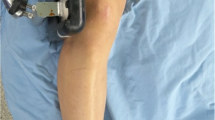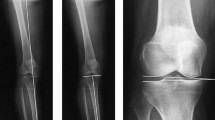Abstract
Introduction
A considerable percentage of outliers with under- or over-correction continue to be reported despite precise preoperative planning and cautious intraoperative correction of lower limb alignment in medial opening-wedge high tibial osteotomy (MOWHTO). The purpose of this study was to determine whether our novel technique for the intraoperative adjustment of alignment under valgus stress reduces the number of outliers in patients undergoing MOWHTO compared to the conventional technique, which corrects alignment according to the cable method only.
Materials and methods
One hundred seventeen consecutive knees were enrolled in this case–control study. The first 52 knees (51 patients) were corrected in accordance with preoperative plans using the Dugdale method with modification with an intraoperative cable (group 1). In the other 65 knees (60 patients), the angle was corrected using the Dugdale method and limb alignment was adjusted using the intraoperative cable technique by applying valgus stress to the knee joint (group 2). The postoperative weight bearing line ratios and mechanical axis of the lower limb were compared at postoperative one year. Each knee was evaluated according to the Western Ontario and McMaster Universities Osteoarthritis Index (WOMAC) score preoperatively and at postoperative one year.
Results
A significant reduction in the number of outliers was seen in group 2 compared to group 1 (group 1 = 48.1%, group 2 = 9.2%, p < 0.001). Nineteen of 52 knees (36.5%) were under-corrected in group 1, whereas 6 of 65 knees (9.2%) were under-corrected in group 2 (p < 0.001). Six of 52 knees (11.6%) were over-corrected in group 1, whereas 0 of 65 knees (0.0%) were over-corrected in group 2 (p = 0.005). At one -year after operation, group 2 showed significantly lower WOMAC score than group 1 (p = 0.014).
Conclusions
Intraoperative adjustment of alignment under valgus stress significantly reduced the number of outliers compared to a technique that corrected alignment using the cable method in patients undergoing MOWHTO.
Level of evidence
Level III, retrospective comparative study.





Similar content being viewed by others
References
Hankemeier S, Mommsen P, Krettek C, Jagodzinski M, Brand J, Meyer C, Meller R (2010) Accuracy of high tibial osteotomy: comparison between open- and closed-wedge technique. Knee Surg Sports Traumatol Arthrosc 18:1328–1333. doi:10.1007/s00167-009-1020-9
Ogawa H, Matsumoto K, Ogawa T, Takeuchi K, Akiyama H (2016) Preoperative varus laxity correlates with overcorrection in medial opening wedge high tibial osteotomy. Arch Orthop Trauma Surg 136:1337–1342. doi:10.1007/s00402-016-2521-x
Petersen W, Metzlaff S (2016) Open wedge high tibial osteotomy (HTO) versus mobile bearing unicondylar medial joint replacement: five years results. Arch Orthop Trauma Surg 136:983–989. doi:10.1007/s00402-016-2465-1
Matsunaga D, Akizuki S, Takizawa T, Yamazaki I, Kuraishi J (2007) Repair of articular cartilage and clinical outcome after osteotomy with microfracture or abrasion arthroplasty for medial gonarthrosis. Knee 14:465–471. doi:10.1016/j.knee.2007.06.008
DeMeo PJ, Johnson EM, Chiang PP, Flamm AM, Miller MC (2010) Midterm follow-up of opening-wedge high tibial osteotomy. Am J Sports Med 38:2077–2084. doi:10.1177/0363546510371371
Sharma L, Song J, Felson DT, Cahue S, Shamiyeh E, Dunlop DD (2001) The role of knee alignment in disease progression and functional decline in knee osteoarthritis. JAMA 286:188–195
Sprenger TR, Doerzbacher JF (2003) Tibial osteotomy for the treatment of varus gonarthrosis. Survival and failure analysis to twenty-two years. J Bone Jt Surg Am 85-a:469–474
Bachhal V, Sankhala SS, Jindal N, Dhillon MS (2011) High tibial osteotomy with a dynamic axial fixator: precision in achieving alignment. J Bone Jt Surg Br 93:897–903. doi:10.1302/0301-620x.93b7.26124
Dugdale TW, Noyes FR, Styer D (1992) Preoperative planning for high tibial osteotomy. The effect of lateral tibiofemoral separation and tibiofemoral length. Clin Orthop Relat Res 274:248–264
El-Azab HM, Morgenstern M, Ahrens P, Schuster T, Imhoff AB, Lorenz SG (2011) Limb alignment after open-wedge high tibial osteotomy and its effect on the clinical outcome. Orthopedics 34:e622–e628. doi:10.3928/01477447-20110826-02
Hawi N, Liodakis E, Suero EM, Meller R, Citak M, Krettek C (2014) A cadaver study comparing intraoperative methods to analyze lower limb alignment. Skeletal Radiol 43:1577–1581. doi:10.1007/s00256-014-1972-9
Hsu RW, Himeno S, Coventry MB, Chao EY (1990) Normal axial alignment of the lower extremity and load-bearing distribution at the knee. Clin Orthop Relat Res 255:215–227
Kendoff D, Board TN, Citak M, Gardner MJ, Hankemeier S, Ostermeier S, Krettek C, Hufner T (2008) Navigated lower limb axis measurements: influence of mechanical weight-bearing simulation. J Orthop Res 26:553–561. doi:10.1002/jor.20510
Krettek C, Miclau T, Grun O, Schandelmaier P, Tscherne H (1998) Intraoperative control of axes, rotation and length in femoral and tibial fractures. Technical note. Injury 29(Suppl 3):C29–C39
Lee DH, Han SB, Oh KJ, Lee JS, Kwon JH, Kim JI, Patnaik S, Shetty GM, Nha KW (2014) The weight-bearing scanogram technique provides better coronal limb alignment than the navigation technique in open high tibial osteotomy. Knee 21:451–455. doi:10.1016/j.knee.2012.09.003
Lee YS, Kim MG, Byun HW, Kim SB, Kim JG (2015) Reliability of the imaging software in the preoperative planning of the open-wedge high tibial osteotomy. Knee Surg Sports Traumatol Arthrosc 23:846–851
Liodakis E, Kenawey M, Liodaki E, Mommsen P, Krettek C, Hankemeier S (2010) The axis-board: an alternative to the cable technique for intraoperative assessment of lower limb alignment. Technol Health Care 18:165–171. doi:10.3233/thc-2010-0579
Oswald MH, Jakob RP, Schneider E, Hoogewoud HM (1993) Radiological analysis of normal axial alignment of femur and tibia in view of total knee arthroplasty. J Arthroplasty 8:419–426
Kyung BS, Kim JG, Jang KM, Chang M, Moon YW, Ahn JH, Wang JH (2013) Are navigation systems accurate enough to predict the correction angle during high tibial osteotomy? Comparison of navigation systems with 3-dimensional computed tomography and standing radiographs. Am J Sports Med 41:2368–2374. doi:10.1177/0363546513498062
Gaasbeek RD, Nicolaas L, Rijnberg WJ, van Loon CJ, van Kampen A (2010) Correction accuracy and collateral laxity in open versus closed wedge high tibial osteotomy. A one-year randomised controlled study. Int Orthop 34:201–207. doi:10.1007/s00264-009-0861-7
Sabharwal S, Zhao C (2008) Assessment of lower limb alignment: supine fluoroscopy compared with a standing full-length radiograph. J Bone Jt Surg Am 90:43–51. doi:10.2106/jbjs.f.01514
Sim JA, Kwak JH, Yang SH, Choi ES, Lee BK (2010) Effect of weight-bearing on the alignment after open wedge high tibial osteotomy. Knee Surg Sports Traumatol Arthrosc 18:874–878. doi:10.1007/s00167-009-1000-0
Lee DC, Byun SJ (2012) High tibial osteotomy. Knee Surg Relat Res 24:61–69. doi:10.5792/ksrr.2012.24.2.61
Fujisawa Y, Masuhara K, Shiomi S (1979) The effect of high tibial osteotomy on osteoarthritis of the knee. An arthroscopic study of 54 knee joints. Orthop Clin North Am 10:585–608
Lobenhoffer P, Agneskirchner JD (2003) Improvements in surgical technique of valgus high tibial osteotomy. Knee Surg Sports Traumatol Arthrosc 11:132–138. doi:10.1007/s00167-002-0334-7
Lee DH, Park SC, Park HJ, Han SB (2015) Effect of soft tissue laxity of the knee joint on limb alignment correction in open-wedge high tibial osteotomy. Knee Surg Sports Traumatol Arthrosc. doi:10.1007/s00167-015-3682-9
Ogata K, Yoshii I, Kawamura H, Miura H, Arizono T, Sugioka Y (1991) Standing radiographs cannot determine the correction in high tibial osteotomy. J Bone Jt Surg Br 73:927–931
Na YG, Eom SH, Kim SJ, Chang MJ, Kim TK (2016) The use of navigation in medial opening wedge high tibial osteotomy can improve tibial slope maintenance and reduce radiation exposure. Int Orthop 40:499–507. doi:10.1007/s00264-015-2880-x
Bellamy N, Buchanan WW, Goldsmith CH, Campbell J, Stitt LW (1988) Validation study of WOMAC: a health status instrument for measuring clinically important patient relevant outcomes to antirheumatic drug therapy in patients with osteoarthritis of the hip or knee. J Rheumatol 15:1833–1840
Takeuchi R, Ishikawa H, Kumagai K, Yamaguchi Y, Chiba N, Akamatsu Y, Saito T (2012) Fractures around the lateral cortical hinge after a medial opening-wedge high tibial osteotomy: a new classification of lateral hinge fracture. Arthroscopy 28:85–94. doi:10.1016/j.arthro.2011.06.034
Chao EY, Neluheni EV, Hsu RW, Paley D (1994) Biomechanics of malalignment. Orthop Clin North Am 25:379–386
Marti CB, Gautier E, Wachtl SW, Jakob RP (2004) Accuracy of frontal and sagittal plane correction in open-wedge high tibial osteotomy. Arthroscopy 20:366–372. doi:10.1016/j.arthro.2004.01.024
Miniaci A, Ballmer FT, Ballmer PM, Jakob RP (1989) Proximal tibial osteotomy. A new fixation device. Clin Orthop Relat Res 246:250–259
Ribeiro CH, Severino NR, Cury Rde P, de Oliveira VM, Avakian R, Ayhara T, de Camargo OP (2009) A new fixation material for open-wedge tibial osteotomy for genu varum. Knee 16:366–370. doi:10.1016/j.knee.2009.01.007
Insall JN, Joseph DM, Msika C (1984) High tibial osteotomy for varus gonarthrosis. A long-term follow-up study. J Bone Jt Surg Am 66:1040–1048
Kim SJ, Koh YG, Chun YM, Kim YC, Park YS, Sung CH (2009) Medial opening wedge high-tibial osteotomy using a kinematic navigation system versus a conventional method: a 1-year retrospective, comparative study. Knee Surg Sports Traumatol Arthrosc 17:128–134. doi:10.1007/s00167-008-0630-y
Lutzner J, Gross AF, Gunther KP, Kirschner S (2010) Precision of navigated and conventional open-wedge high tibial osteotomy in a cadaver study. Eur J Med Res 15:117–120
Kawakami H, Sugano N, Yonenobu K, Yoshikawa H, Ochi T, Hattori A, Suzuki N (2004) Effects of rotation on measurement of lower limb alignment for knee osteotomy. J Orthop Res 22:1248–1253. doi:10.1016/j.orthres.2004.03.016
Akamatsu Y, Mitsugi N, Mochida Y, Taki N, Kobayashi H, Takeuchi R, Saito T (2012) Navigated opening wedge high tibial osteotomy improves intraoperative correction angle compared with conventional method. Knee Surg Sports Traumatol Arthrosc 20:586–593. doi:10.1007/s00167-011-1616-8
Iorio R, Pagnottelli M, Vadala A, Giannetti S, Di Sette P, Papandrea P, Conteduca F, Ferretti A (2013) Open-wedge high tibial osteotomy: comparison between manual and computer-assisted techniques. Knee Surg Sports Traumatol Arthrosc 21:113–119. doi:10.1007/s00167-011-1785-5
Maurer F, Wassmer G (2006) High tibial osteotomy: does navigation improve results? Orthopedics 29:S130–S132
Gebhard F, Krettek C, Hufner T, Grutzner PA, Stockle U, Imhoff AB, Lorenz S, Ljungqvist J, Keppler P (2011) Reliability of computer-assisted surgery as an intraoperative ruler in navigated high tibial osteotomy. Arch Orthop Trauma Surg 131:297–302. doi:10.1007/s00402-010-1145-9
Hankemeier S, Hufner T, Wang G, Kendoff D, Zheng G, Richter M, Gosling T, Nolte L, Krettek C (2005) Navigated intraoperative analysis of lower limb alignment. Arch Orthop Trauma Surg 125:531–535. doi:10.1007/s00402-005-0038-9
Dexel J, Fritzsche H, Beyer F, Harman MK, Lutzner J (2015) Open-wedge high tibial osteotomy: incidence of lateral cortex fractures and influence of fixation device on osteotomy healing. Knee Surg Sports Traumatol Arthrosc. doi:10.1007/s00167-015-3730-5
Miller BS, Downie B, McDonough EB, Wojtys EM (2009) Complications after medial opening wedge high tibial osteotomy. Arthroscopy 25:639–646. doi:10.1016/j.arthro.2008.12.020
Nelissen EM, van Langelaan EJ, Nelissen RG (2010) Stability of medial opening wedge high tibial osteotomy: a failure analysis. Int Orthop 34:217–223. doi:10.1007/s00264-009-0723-3
van Raaij TM, Brouwer RW, de Vlieger R, Reijman M, Verhaar JA (2008) Opposite cortical fracture in high tibial osteotomy: lateral closing compared to the medial opening-wedge technique. Acta Orthop 79:508–514. doi:10.1080/17453670710015508
Nakamura R, Komatsu N, Murao T, Okamoto Y, Nakamura S, Fujita K, Nishimura H, Katsuki Y (2015) The validity of the classification for lateral hinge fractures in open wedge high tibial osteotomy. Bone Jt J 97-b:1226–1231. doi:10.1302/0301-620x.97b9.34949
Agneskirchner JD, Freiling D, Hurschler C, Lobenhoffer P (2006) Primary stability of four different implants for opening wedge high tibial osteotomy. Knee Surg Sports Traumatol Arthrosc 14:291–300. doi:10.1007/s00167-005-0690-1
Schroter S, Gonser CE, Konstantinidis L, Helwig P, Albrecht D (2011) High complication rate after biplanar open wedge high tibial osteotomy stabilized with a new spacer plate (Position HTO plate) without bone substitute. Arthroscopy 27:644–652. doi:10.1016/j.arthro.2011.01.008
Stoffel K, Stachowiak G, Kuster M (2004) Open wedge high tibial osteotomy: biomechanical investigation of the modified Arthrex Osteotomy Plate (Puddu Plate) and the TomoFix Plate. Clin Biomech (Bristol Avon) 19:944–950. doi:10.1016/j.clinbiomech.2004.06.007
Author information
Authors and Affiliations
Corresponding author
Ethics declarations
Conflict of interest
The authors have no conflicts of interest to declare.
Funding
There is no funding source.
Ethical approval
All procedures performed in studies involving human participants were in accordance with the ethical standards of the institutional and/or national research committee and with the 1964 Declaration of Helsinki and its later amendments or comparable ethical standards.
Informed consent
Informed consent was obtained from all individual participants included in the study.
Rights and permissions
About this article
Cite this article
Kim, M.S., Son, J.M., Koh, I.J. et al. Intraoperative adjustment of alignment under valgus stress reduces outliers in patients undergoing medial opening-wedge high tibial osteotomy. Arch Orthop Trauma Surg 137, 1035–1045 (2017). https://doi.org/10.1007/s00402-017-2729-4
Received:
Published:
Issue Date:
DOI: https://doi.org/10.1007/s00402-017-2729-4




